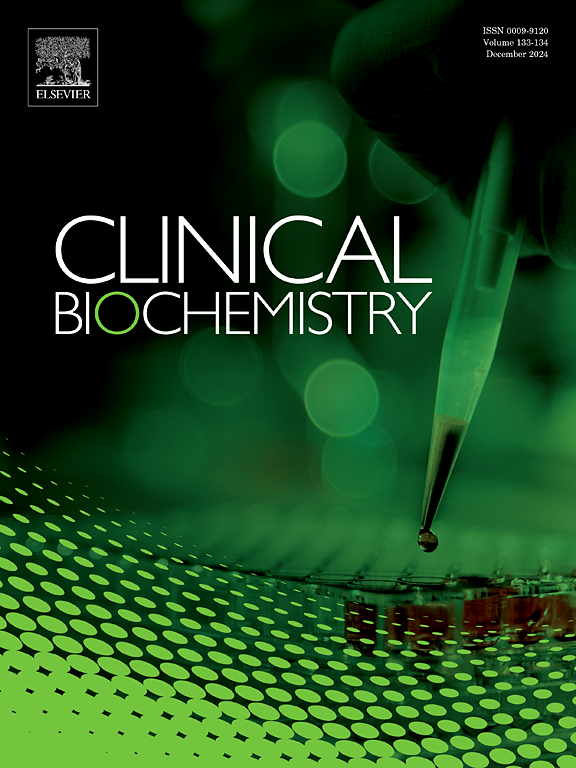诊断蛋白质S缺乏症-导航挑战。
IF 2.1
3区 医学
Q2 MEDICAL LABORATORY TECHNOLOGY
引用次数: 0
摘要
目的:描述诊断蛋白S缺乏症的挑战。方法:1例20岁晚期( )妊娠晚期(G1P0)非出血性肾上腺梗死患者。在产后5个月进行血栓检测,包括V莱顿因子(FVL;NM_000130: c.1601G > ;rs6025)和凝血酶原c. 20210g > A (NM_000506:c.*97G > A;rs1799963)变异,以及抗磷脂抗体、蛋白C (PC)活性和抗原、蛋白S (PS)活性和抗原、抗凝血酶的测定。初步检测提示PS缺乏类型未知。因此,使用Sanger测序和多重连接依赖探针扩增对PROS1基因进行了靶向遗传筛选,以排除大的结构DNA重排,并进行了反复的血栓形成测试。结果:第一轮血栓病检测发现低PS和PC,以及FVL变异的杂合性。已知FVL错误地降低PS活性高达15% %,但不影响抗原测定(游离和总PS水平)。鉴定出PROS1变异(c.698G > A;p.(Arg233Lys)),但由于这种变异相对常见,我们将其归类为可能是良性的。在第一次测试后8 个月进行最后一轮血栓检测,结果显示PC活性正常,PS总量正常,PS游离低正常阈值,PS活性低。结论:凝血检测和PROS1基因分型均不符合PS缺乏标准。该病例强调了制定明确的指导方针以确定PROS1基因检测在常规临床实践中的作用的必要性。本文章由计算机程序翻译,如有差异,请以英文原文为准。
Diagnosing protein S deficiency − Navigating challenges
Objective
Describe challenges in diagnosing protein S deficiency.
Methods
A women in her late 20 s and pregnant in third trimester (G1P0) suffered non-hemorrhagic adrenal infarction. Thrombophilia testing was performed five months post-partum and included analyses for the factor V Leiden (FVL; NM_000130:c.1601G > A; rs6025) and prothrombin c.20210G > A (NM_000506:c.*97G > A; rs1799963) variants, and measurement of antiphospholipid antibodies, protein C (PC) activity and antigen, protein S (PS) activity and antigen, and antithrombin. Initial testing suggested PS deficiency of unknown type. Therefore, targeted genetic screening of the PROS1 gene was performed using Sanger sequencing and multiplex ligation-dependent probe amplification to rule out large structural DNA rearrangements, along with repeated thrombophilia testing.
Results
The first round of thrombophilia testing found low PS and PC, and heterozygosity for the FVL variant. FVL is known to falsely reduce PS activity up to 15 %, but not influence antigen assays (free and total PS levels). A PROS1 variant was identified (c.698G > A; p.(Arg233Lys)), but as this is relatively common, we classified the variant as likely benign. The final round of thrombophilia testing was performed 8 months after the first, and showed normal PC activity, normal PS total, PS free at the lower normal threshold and low PS activity.
Conclusion
The patient does not meet the criteria for PS deficiency based on either coagulation assays or PROS1 gene genotyping. This case highlights the necessity for clear guidelines to define the role of PROS1 genetic testing in routine clinical practice.
求助全文
通过发布文献求助,成功后即可免费获取论文全文。
去求助
来源期刊

Clinical biochemistry
医学-医学实验技术
CiteScore
5.10
自引率
0.00%
发文量
151
审稿时长
25 days
期刊介绍:
Clinical Biochemistry publishes articles relating to clinical chemistry, molecular biology and genetics, therapeutic drug monitoring and toxicology, laboratory immunology and laboratory medicine in general, with the focus on analytical and clinical investigation of laboratory tests in humans used for diagnosis, prognosis, treatment and therapy, and monitoring of disease.
 求助内容:
求助内容: 应助结果提醒方式:
应助结果提醒方式:


